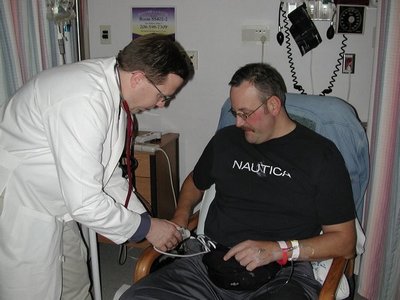January 5, 2006
New device helps those awaiting heart transplants
As a Washington state trooper patrolling the streets of Olympia, 39-year-old Matt Stone was trained to expect the unexpected. Once, during a routine traffic stop, a passing semi-truck side-swiped his parked patrol car, knocking him over the guardrail and into some nearby bushes. A close call to be sure, but he managed to dodge what could have been a fatal outcome.
Today, Stone is the survivor of a different kind of unexpected turn his life took nearly six years ago. In March 2000, suffering from flu-like symptoms, he took the advice of his wife Julie, a registered nurse in cardiology, and went to see his primary care physician in Olympia. After a thorough exam, Stone’s doctor determined he was suffering from cardiomyopathy and admitted him to the hospital, where he had a defibrillator implanted to help regulate his heartbeat. Afterward, his return to work at the state patrol was limited to desk duties.
At the recommendation of his cardiologist in Olympia, Stone began making regular appointments at the UW Medicine Regional Heart Center with Dr. Daniel Fishbein, medical director for end-stage heart failure and cardiac transplantation. However, despite careful monitoring and adjustments of his medications, his health continued to decline.
“Then in January 2005, my heart gave out altogether,” he said, describing the experience as “a sudden-death episode.” His defibrillator shocked him twice and revived him, but it was becoming clear to his physicians and family that he would eventually need a new heart to survive.
In August 2005, Dr. Chris Salerno, UW assistant professor of cardiothoracic surgery, implanted Stone with a HeartMate II ventricular assist device — a new device now in clinical trial at UW Medical Center. UWMC currently offers five different types of ventricular assist devices, or VADs, which are surgically implanted to assist the heart in pumping blood throughout the body and to stabilize patients awaiting heart transplants.
The HeartMate II is a smaller, quieter and more durable device that takes over the function of a failing heart and can serve as a “bridge” to heart transplant for a patient for up to five years until a heart is located. Determining whether an available heart is the right match depends on several factors, including the patient’s blood type, the level of antibodies present, and the size of the heart in relation to the patient’s body mass.
“Matt was very ill going into the OR and, given his particular blood type and size, we knew finding the right heart could take some time,” Salerno said. “So the HeartMate II was a good choice — and one Matt was willing to make.”
The implanted device connects to a tube that protrudes below Stone’s right rib cage and hooks into a small pack worn around the waist that contains a power supply and control circuit. The power-based unit is designed to plug into an outlet at home, while the mobile unit allows the patient more freedom of movement through the use of a battery pack.
So how is Stone doing today?
“Fantastic. He couldn’t be doing better,” Salerno said.
In November 2005, three months after Stone received his HeartMate II, the UW Medical Center celebrated the 20th anniversary of the first heart transplant here with a special dinner event honoring heart transplant recipients and donor families.
“We’ve come a long way in replacing hearts since 1985,” Salerno said. “Back in the 1970s, Life magazine called heart transplantation ‘a bust.’ Today, the University of Washington’s heart transplant program has a greater than 90 percent survival rate after one year and a 70 percent survival rate after 10 years.”
For Stone, waiting for a new heart has shown him another side of life. While he is limited in his day-to-day activities — he can no longer play physically active sports with his 10-year-old son and 8-year-old daughter — he is also the beneficiary of “an amazing support system,” he said.
Family, friends, neighbors and colleagues from work have all pitched in to help out when errands need to be run or kids need to be transported.
“Their support has really taken some of the stress off of us,” said Julie.
Last month Stone returned to his job as a Washington state trooper in Olympia. His adjustment from patrolling the streets to working behind a desk has been “a little tough,” he admits, but he has been promoted twice since he first became ill nearly six years ago. Today he is a lieutenant with the Washington State Patrol.
But Stone is quick to emphasize that his health and his family come first.
“You just have to re-prioritize everything in your life,” he explains. “Your health takes center stage, as does your family, and everything else falls into line behind those top two priorities,” he said.
Julie admits she used to be the official family planner, mapping out future vacations well in advance and organizing fun family excursions for the kids.
“Now we’ve become a day-to-day family,” she said. “What’s ‘normal’ for us today is much different than it was five years ago.”
“Yeah, but it’s a whole lot more normal since I got this HeartMate II,” Stone said, smiling widely.



